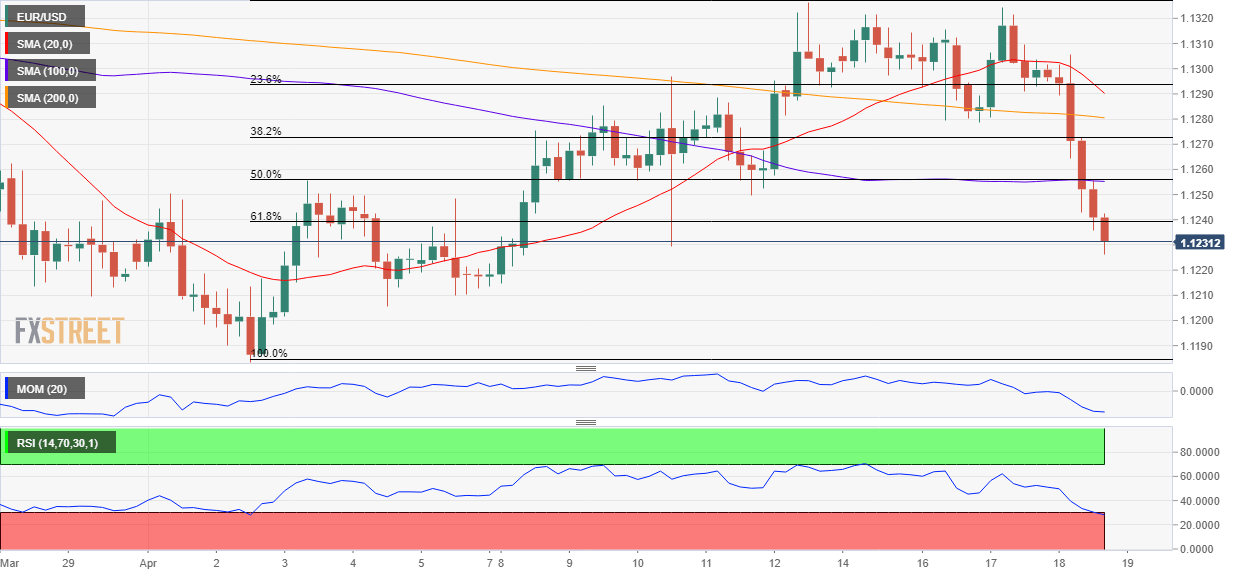EUR/USD Current Price: 1.1232
- German's manufacturing activity remained depressed in April.
- Upbeat US Retail Sales further fueled dollar's gains.
The EUR/USD pair fell to 1.1225, its lowest for this week, as the latest Markit PMI confirmed that the sluggish growth in the Union has extended into the beginning of the second quarter, backing the case of ECB's stimulus. German manufacturing activity bounced modestly in March according to preliminary estimates, although the PMI remained in contraction territory at 44.5. The Services sector did a bit better, with the PMI surging to a 7-month high of 55.6, resulting in the Composite index improving to 52.1. Other countries such as France and Italy, did better-than-expected with the indexes bouncing, yet for the whole Union, German's soft figures weighed, with the Manufacturing index resulting in at 47.8 and the services one at 52.5, both missing the market's expectations.
US data released ahead of Wall Street's open gave the pair another push lower, as Retail Sales were up by 1.6% MoM in March vs. the 0.9% forecasted. The Retail Sales Control Group increased by 1.0% against the market's expectations of a 0.4% advance. The US also released unemployment claims, which decreased to 193 K vs. the expected 205K in the week ended April 5, a new almost five-decade low. The April Philadelphia Fed Manufacturing Survey showed that business activity kept growing, although at a slower pace than anticipated, with the index printing 8.5 vs. 10.4 forecasted. However, the Markit April reports missed expectations, putting a temporal halt to the dollar's strength. The Manufacturing Index printed 52.4, matching the March figure, while the Services index declined to 52.9 from the previous 55.3.
The greenback heads quite strong into the Asian session, with only Japanese markets´ open, as the rest of the region will celebrate Good Friday, as well as all European countries. In the US, Friday is not a holiday, but both the NYSE and the NASDAQ will remain closed. Activity is expected to remain restricted. The 4 hours chart shows that the pair is struggling with the 61.8% retracement of the 1.1183/1.1323 rally at around 1.1235, while extending its decline below its moving averages, all of them gaining downward traction. Technical indicators maintain their bearish slopes near overbought levels, keeping the risk skewed to the downside and exposing 1.1175 the yearly low.
Support levels: 1.1200 1.1175 1.1140
Resistance levels: 1.1245 1.1280 1.1320
Information on these pages contains forward-looking statements that involve risks and uncertainties. Markets and instruments profiled on this page are for informational purposes only and should not in any way come across as a recommendation to buy or sell in these assets. You should do your own thorough research before making any investment decisions. FXStreet does not in any way guarantee that this information is free from mistakes, errors, or material misstatements. It also does not guarantee that this information is of a timely nature. Investing in Open Markets involves a great deal of risk, including the loss of all or a portion of your investment, as well as emotional distress. All risks, losses and costs associated with investing, including total loss of principal, are your responsibility. The views and opinions expressed in this article are those of the authors and do not necessarily reflect the official policy or position of FXStreet nor its advertisers. The author will not be held responsible for information that is found at the end of links posted on this page.
If not otherwise explicitly mentioned in the body of the article, at the time of writing, the author has no position in any stock mentioned in this article and no business relationship with any company mentioned. The author has not received compensation for writing this article, other than from FXStreet.
FXStreet and the author do not provide personalized recommendations. The author makes no representations as to the accuracy, completeness, or suitability of this information. FXStreet and the author will not be liable for any errors, omissions or any losses, injuries or damages arising from this information and its display or use. Errors and omissions excepted.
The author and FXStreet are not registered investment advisors and nothing in this article is intended to be investment advice.
Recommended Content
Editors’ Picks
AUD/USD could extend the recovery to 0.6500 and above

The enhanced risk appetite and the weakening of the Greenback enabled AUD/USD to build on the promising start to the week and trade closer to the key barrier at 0.6500 the figure ahead of key inflation figures in Australia.
EUR/USD now refocuses on the 200-day SMA

EUR/USD extended its positive momentum and rose above the 1.0700 yardstick, driven by the intense PMI-led retracement in the US Dollar as well as a prevailing risk-friendly environment in the FX universe.
Gold struggles around $2,325 despite broad US Dollar’s weakness

Gold reversed its direction and rose to the $2,320 area, erasing a large portion of its daily losses in the process. The benchmark 10-year US Treasury bond yield stays in the red below 4.6% following the weak US PMI data and supports XAU/USD.
Bitcoin price makes run for previous cycle highs as Morgan Stanley pushes BTC ETF exposure

Bitcoin (BTC) price strength continues to grow, three days after the fourth halving. Optimism continues to abound in the market as Bitcoiners envision a reclamation of previous cycle highs.
US versus the Eurozone: Inflation divergence causes monetary desynchronization

Historically there is a very close correlation between changes in US Treasury yields and German Bund yields. This is relevant at the current juncture, considering that the recent hawkish twist in the tone of the Federal Reserve might continue to push US long-term interest rates higher and put upward pressure on bond yields in the Eurozone.
